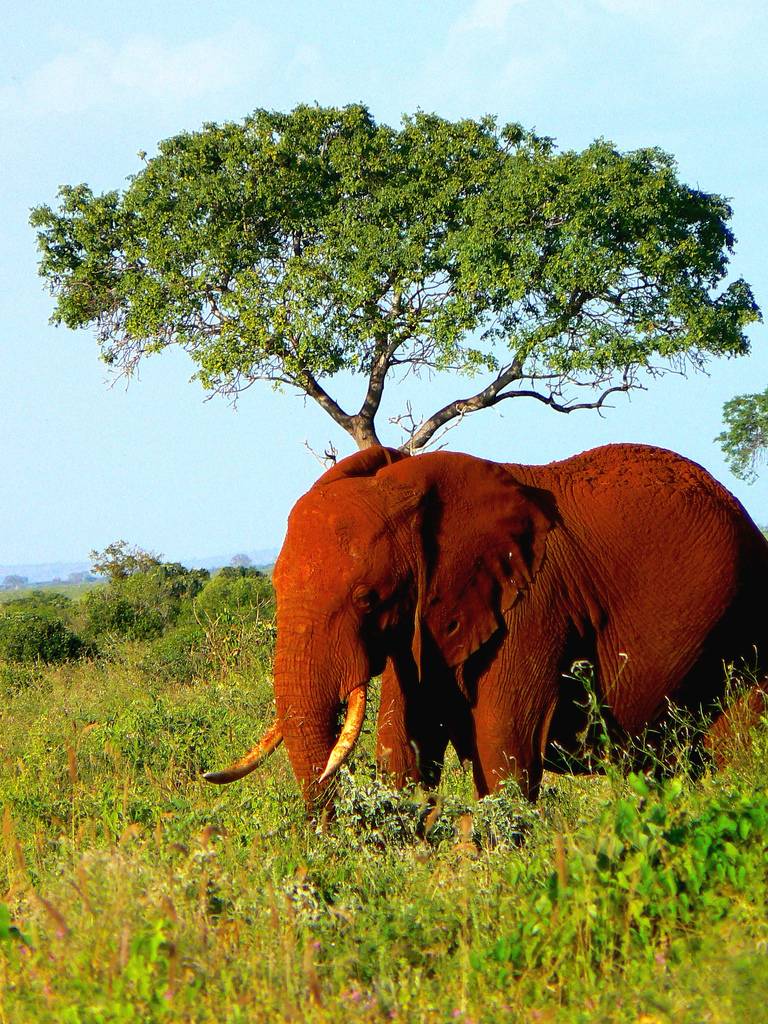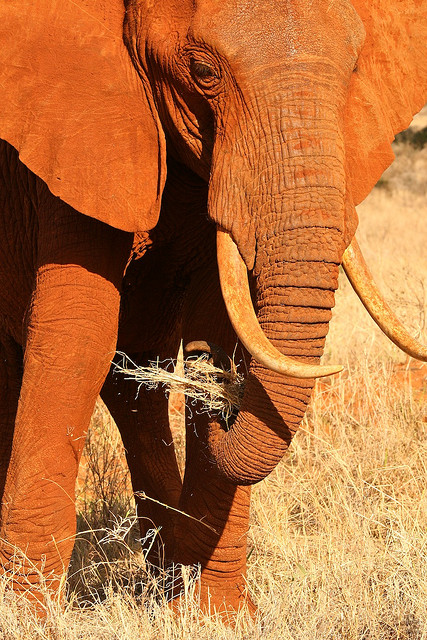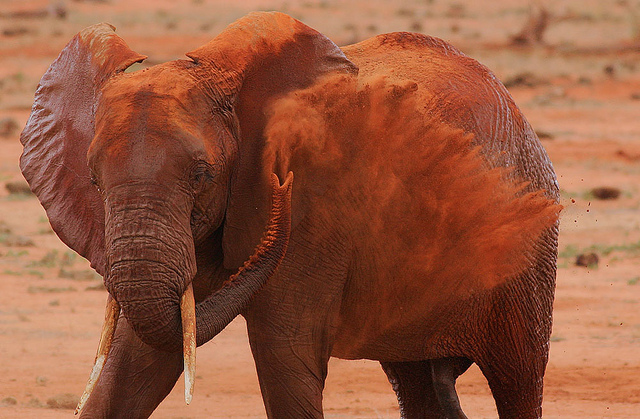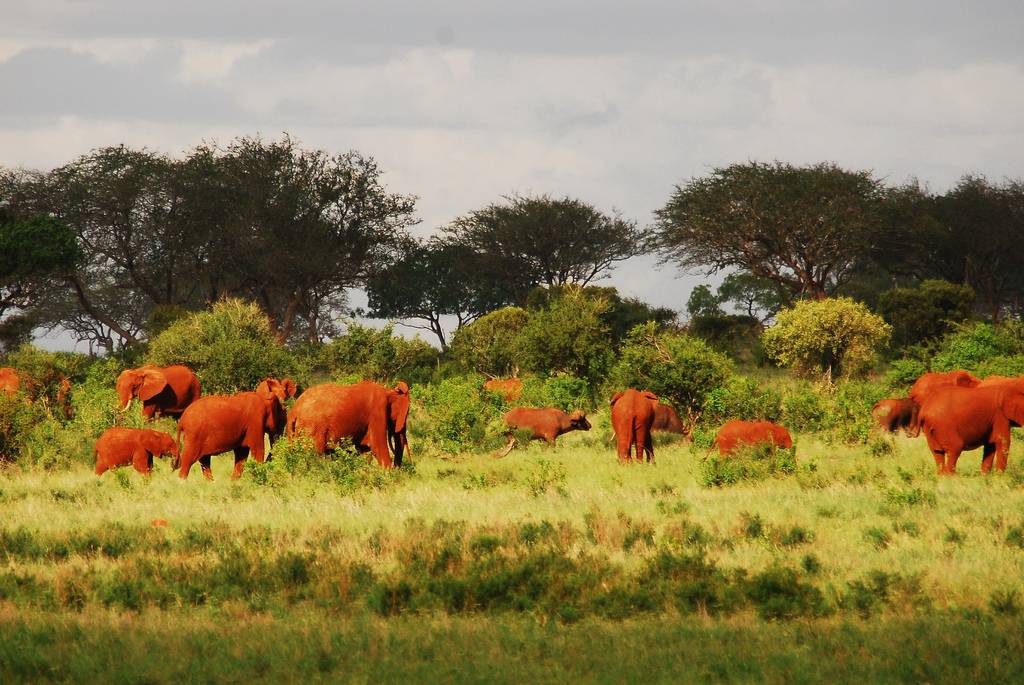Hi friends ......enjoy a ride with African elephants. The Red Elephants of Kenya Ask anyone what color an elephant should be and you may get a raised eyebrow (or two) but the answer will normally be grey or greyish – perhaps even black or brown. The more observant might say there is pinkness around some parts of the body such as the ears and trunk. Red would almost certainly not be the answer even though some would swear they had witnessed pink elephants on parade. Yet in the Kenyan National Park of Tsavo East you will find red elephants aplenty. Image Credit Flickr User Fagasam However, as you have probably already assumed, this is not the way the elephants were born. The dusty soil of Tsavo is naturally of this color and the elephants regularly partake of dust baths. The dust serves as an important anesthetic to protect the elephant's skin. It also has the added bonus of shining up their tusks in to an almost silver appearance.Image Credit Flickr User Marius Kucharczyk Image Credit Flickr User Marius Kucharczyk The elephants take every opportunity they can to bathe in water holes and rivers in the park (Tsavo itself means river in Maasai). They emerge in a new, rather rubicund form. As they dry the mud deposited remains on their skin and their color has effectively changed. Image Credit Flickr User Marco After an energetic and enthusiastic wallow in the mud these elephants are simply ablaze. Describe the colour how you will – vermilion, claret, terracotta, burgundy – the elephants seem somehow elevated by their reddened shade, almost as if they have been through a kind of anointment.Image Credit Flickr User Steve Garvie Even when there is no water available they bathe themselves in the soil by swishing large quantities over their bodies using their trunks. Against the backdrop of the Kenyan earth it looks like the perfect camouflage although they have no natural predators here except lions.Image Credit Flickr User Marius Kucharczyk Tsavo is famous for its man-eating lions but they are not averse to elephant either. They will target the very young calves and the frail and often attack at night as their eyesight then is much better than that of the elephants. They will attempt to separate their quarry from the herd and bring it down before the mother has a chance to spot the attack and stamp on a few lions' heads.Image Credit Flickr User Fabcom However, lions do not predate the red elephants in any large numbers. Although the elephants face numerous problems from this harsh environment, poaching is the foremost. As well as depleting their numbers this most vindictive of human activities targets bulls and large elephants – those with the largest tusks. This in turn endangers the health of future generations of those weaker and smaller animals which remain.Image Credit Flickr User Mariusz Kucharczyk The silvery tusks of the red elephants of Kenya are too much of a temptation for some to resist. When you consider that a pair of tusks sold on the black market can sustain an unskilled Kenyan worker financially for ten years it is easy to see why so many men are enticed in to illegal poaching. Yet the statistics are frightening. In 1970 it was thought that Tsavo was home to 35,000 elephants. By 2005 that number had fallen to 10,000. Image Credit Flickr User Mariusz Kucharczyk As humans encroach more on elephant territory conflict is inevitable. Elephants can inadvertently destroy subsistence crops and are seen as a nuisance by some local people. Yet there is work being done. The Earthwatch Institute is conducting surveys to ascertain the movement of the elephants so that safe pathways can be established to keep both elephants and people safe. Image Credit Flickr User Mariusz Kucharczyk Of course the elephants are in the largest National Park in Kenya and that should make a positive difference to their future. It can only be hoped that their decline can be halted and that many future generations of red elephants will grace the plains and hills of Tsavo. Image Credit Flickr User Marius Kucharczyk Image Credit Flickr User Marius Kucharczyk Image Credit Flickr User Marius Kucharczyk Image Credit Flickr User Marius Kucharczyk Image Credit Flickr User Fagasam Image Credit Flickr User Adam Wood Image Credit Flickr User Marius Kucharczyk Image Credit Flickr User Adam.Wood Image Credit Flickr User Adam.Wood First Image Credit Flickr User Mariusz Kucharczyk Mohan K. Ponnath |
www.keralites.net         |
__._,_.___
KERALITES - A moderated eGroup exclusively for Keralites...
To subscribe send a mail to Keralites-subscribe@yahoogroups.com.
Send your posts to Keralites@yahoogroups.com.
Send your suggestions to Keralites-owner@yahoogroups.com.
To unsubscribe send a mail to Keralites-unsubscribe@yahoogroups.com.
Homepage: www.keralites.net
To subscribe send a mail to Keralites-subscribe@yahoogroups.com.
Send your posts to Keralites@yahoogroups.com.
Send your suggestions to Keralites-owner@yahoogroups.com.
To unsubscribe send a mail to Keralites-unsubscribe@yahoogroups.com.
Homepage: www.keralites.net
.
__,_._,___










































No comments:
Post a Comment